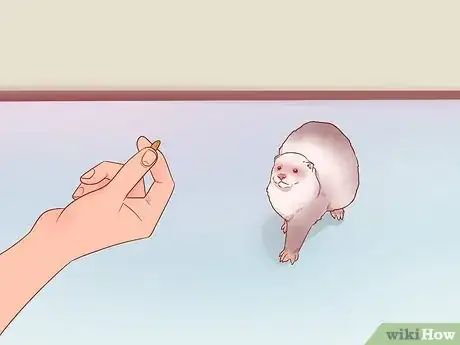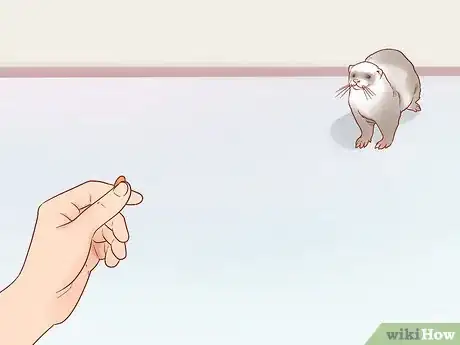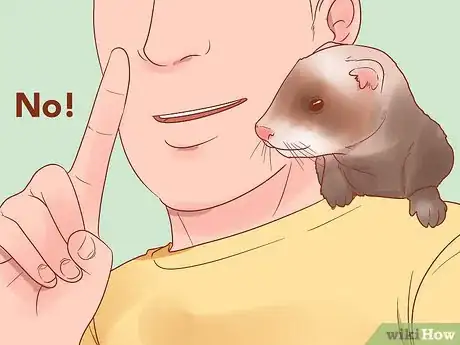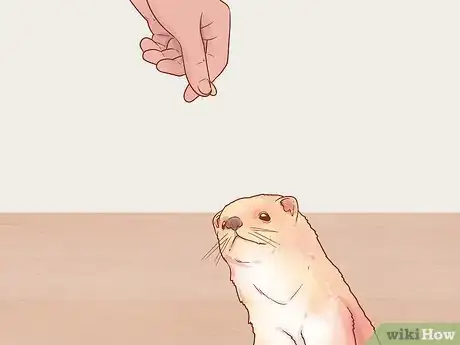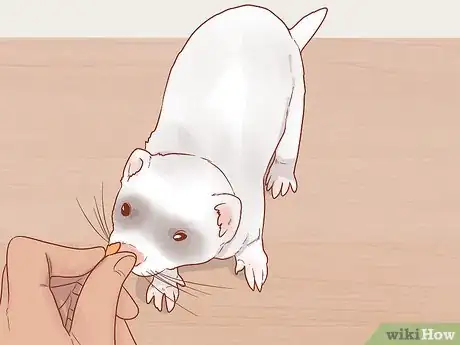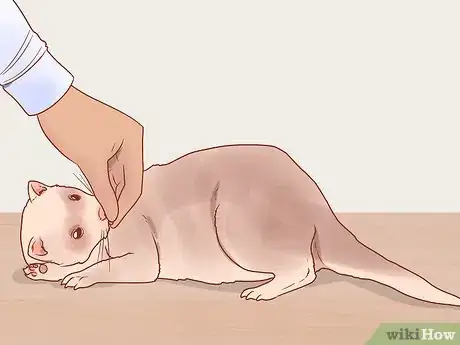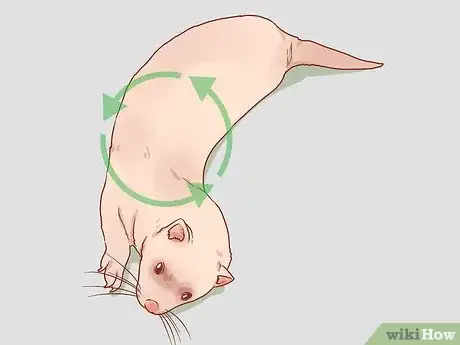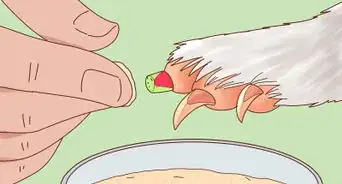This article was co-authored by Pippa Elliott, MRCVS. Dr. Elliott, BVMS, MRCVS is a veterinarian with over 30 years of experience in veterinary surgery and companion animal practice. She graduated from the University of Glasgow in 1987 with a degree in veterinary medicine and surgery. She has worked at the same animal clinic in her hometown for over 20 years.
wikiHow marks an article as reader-approved once it receives enough positive feedback. In this case, 95% of readers who voted found the article helpful, earning it our reader-approved status.
This article has been viewed 153,381 times.
Ferrets are fun and intelligent pets and you can teach them a few different tricks. Ferrets aren't quite as obedient as dogs, and probably can't be trained to do sophisticated tricks like running an obedience course or balancing objects on their noses. However, with a little patience, you can teach ferrets basic tricks like coming when you call, sitting, lying down, and even rolling over. All you'll need are a few treats, pieces of the ferret's favorite food or a 1⁄2 inch (1.3 cm) strip of cooked chicken breast.[1]
Steps
Teaching Your Ferret to Come to You
-
1Isolate 1 ferret from the others in a neutral location. If you own multiple ferrets, select 1 that you'd like to train first. Bring it to a room in your home with which the animal has no negative associations, like your living room. Spend 10–15 minutes training a ferret and then, if you have time, train the subsequent ferrets for the same amount of time. They'll learn relatively quickly this way.[2]
- If you try to train multiple ferrets at once, it's unlikely that they'll learn anything. They'll be too busy playing around and distracting one another.
-
2Hold a treat about 1 foot (0.30 m) in front of the ferret. At this distance, the animal will easily recognize the treat. As soon as the ferret makes a move for the treat in your hand, say "come" loud and clear. Let the ferret approach you and eat the treat so it begins to understand that it's being rewarded for coming to you.[3]
- You could use another command if you prefer. For example, say the animal's name, or just call out the word “treats!”
Advertisement -
3Train the ferret with the treat farther away from its face. Begin holding the treat 2 feet (0.61 m) away from the animal, then 4 feet (1.2 m), then 5 feet (1.5 m), and then as far as you like.[4] Repeat the steps that you used before: let the ferret recognize the treat, say “come,” and let the ferret approach and take the treat. Once the ferret begins to come on command, try calling it from a different room.
- If the ferret goes for the treat before you say, "Come" then try hiding the treat in your hand and say "Come" and show the treat.
- Try saying the word “Come” whenever your ferret moves toward you on its own, and then reward it. This helps them learn that “Come” action comes with a reward.
-
4Repeat the training until the ferret has learned the behavior. All training relies on repetition and reward. So, train the ferret at least 5-10 times in a row, giving it a reward every time it comes to you after you call it. With time, the ferret will improve and will eventually come when you call, regardless of where the animal is in your home.[5]
- Once the ferret comes every time you call, you can gradually phase out the use of treats.
Training the Ferret to Sit on Your Shoulder
-
1Train the ferret over a soft surface. For example, pick a location like your bed, so that if the ferret falls, it won't land on the floor and get hurt. You could also sit in a chair or on a sofa. Until your ferret is comfortable sitting on your shoulder, never walk over a hard surface with the animal perched on top of you.
-
2Place the ferret on your shoulders and give it a treat. Also firmly say the word “steady.” Over time, the ferret will come to associate this verbal command with staying in place on your shoulders. Pet the animal and give it a few scratches under its chin so it associates perching on your shoulder with positive reinforcement.[6]
- While the ferret perches, speak to it in a kind, encouraging tone.
-
3Say “no” in a sharp voice if the ferret tries to jump off. With a few repetitions, your ferret will figure out that it's rewarded if it stays on your shoulder and chastised if it tries to jump down.[7] Since it will take the ferret some time to learn the trick, let it dismount after about 10 seconds.
- Even if the ferret does jump down, never strike the animal or shout at it out of anger.
-
4Train the ferret to sit on your shoulder for longer periods of time. As before, place a treat on your shoulder, lift the ferret up, and command it: “steady.” Once it's comfortable with staying in place for 10 seconds, move on to 20 seconds, then 30 seconds, then 1 minute. With enough repetitions (and enough rewards), your ferret will learn to sit on your shoulder for as long as you'd like it to.[8]
- At this point, you can freely walk around your home with the ferret on your shoulder.
Training a Ferret to Sit
-
1Hold a treat 6 inches (15 cm) above the ferret's head. Once your ferret notices that there's a tasty treat just above its head, it will rest on its haunches and sit upright to move its mouth closer to the treat.[9]
- Make sure that the treat isn't too high or else the ferret might jump to get it.
-
2Say “sit” once your ferret has moved into a seated position. The repeated verbal command will help your ferret learn to associate the behavior of sitting with the word “sit.” So, as soon as your ferret lowers its bottom to sit while it looks up at the treat, say "sit" loud and clear.[10]
-
3Give the ferret the treat as soon as it's in a seated position. Repeat this process 10–15 times over a 20–minute window (or until your ferret loses its appetite). After a few repetitions, the ferret will understand that you're giving it the treat as a reward for sitting.[11]
- If you don't give the ferret the treat right away, it will either jump up and snatch the treat from your fingers or lose interest altogether, neither of which will help with its training.
-
4Praise and pet the ferret just after giving it the treat. This will give the animal further positive reinforcement and help it learn to sit on command more quickly.[12] Speak in an affectionate tone and say “nice work!” “good boy!” or “good girl!”
-
5Phase out treats as your ferret learns to sit. Since it would be impractical to always have chicken breast (or other food treats) on hand to give your ferret whenever it sits, stop giving your ferret a treat every time it sits down.[13] Start by cutting back to 3/4 of the time, then half, then 1/4, and then stop giving treats altogether. Still give your ferret verbal praise and pets when it sits down, though.
- In a few weeks or a couple months, your ferret will be well trained and will sit down when you give it the verbal command with or without a treat.
Teaching Ferrets to Lay Down and Roll Over
-
1Place a treat on the ground in front of your prostrate ferret. It's best to start this trick when your ferret is lying down on the ground, rather than trying to press it down with your hands. So, wait for an opportune moment when your ferret is in a prone position, and place a treat about 8 inches (20 cm) in front of the animal's face.[14]
- If the ferret hunches its back and scoots its rear end forward to reach the treat, keep moving the treat backward away from the ferret until it stretches itself out flat to reach the treat.
-
2Say “lay down” and give the treat to the ferret once it's prone. As soon as the ferret lays down to get the treat, give it the verbal command: "lay down!" and slide the treat forward so the ferret can easily snap it up. Speak the command and move the treat simultaneously, so the animal comes to associate laying down with the words “lay down” and a treat.[15]
- Don't try to put the treat directly into the ferret's mouth, or it could accidentally bite the tips of your fingers.
-
3Repeat the command process 5-6 times in a 20-minute period. Your ferret will only learn through repetition, so don't stop the training session after your ferret lies down once. Wait for it to recline a second time, then repeat the process: place a treat in front of the animal, say, “lay down,” and give the ferret the treat.[16] With enough repetitions over a period of days or weeks, the ferret will learn to lay down on command.
- If you try to keep training the ferret for much longer than 20 minutes, you'll exhaust its patience and it will stop listening.
-
4Circle a treat around the ferret's mouth to teach it to roll over. Tell your ferret “lay down.” Hold a treat about 7 inches (18 cm) in the air and move the treat behind the animal's head. The ferret should roll over onto its back so it can keep an eye on the treat.[17] As soon as it rolls, give the animal the treat and say “roll over!”
- Practice this 8-10 times in a row, always giving the ferret the treat once it's on its back.
-
5Move the treat in a full circle above your ferret's head. This should make the ferret roll completely over. Only move on to this step once your ferret is used to rolling on its back and hearing the “roll over” command. Continue to say “roll over” as you move the treat around the ferret's head, but don't give the animal the treat until it's rolled completely over and is again lying on its stomach.[18]
- Remember to give your ferret verbal praise when it completes a roll-over. Say “good job!” in an encouraging tone of voice.
-
6Practice these steps until your ferret regularly rolls over on command. In a single 20–30 minute training session, try to have your ferret roll completely over at least half a dozen times. It may take some prompting (or multiple treats per attempt) since this is a more complex trick than sitting or lying down. But, with time and repetition, your ferret will learn to roll on command.[19]
- Once it's learned to roll on command, try pairing this with a couple of other tricks. For example, ask the ferret to sit, lie down, and then roll over.
References
- ↑ https://www.petcoach.co/article/training-ferrets/
- ↑ https://www.petcoach.co/article/training-ferrets/
- ↑ https://www.petcoach.co/article/training-ferrets/
- ↑ https://www.petcoach.co/article/training-ferrets/
- ↑ https://www.petcoach.co/article/training-ferrets/
- ↑ https://all-about-ferrets.com/teaching-your-ferret-tricks.html
- ↑ https://all-about-ferrets.com/teaching-your-ferret-tricks.html
- ↑ https://all-about-ferrets.com/teaching-your-ferret-tricks.html
- ↑ https://all-about-ferrets.com/teaching-your-ferret-tricks.html
- ↑ https://all-about-ferrets.com/teaching-your-ferret-tricks.html
- ↑ https://all-about-ferrets.com/teaching-your-ferret-tricks.html
- ↑ https://all-about-ferrets.com/teaching-your-ferret-tricks.html
- ↑ https://all-about-ferrets.com/teaching-your-ferret-tricks.html
- ↑ https://www.vetbabble.com/small-pets/ferrets/ferret-training/
- ↑ https://www.vetbabble.com/small-pets/ferrets/ferret-training
- ↑ https://www.vetbabble.com/small-pets/ferrets/ferret-training/
- ↑ https://www.vetbabble.com/small-pets/ferrets/ferret-training/
- ↑ https://www.vetbabble.com/small-pets/ferrets/ferret-training/
- ↑ https://www.vetbabble.com/small-pets/ferrets/ferret-training/
About This Article
To train your ferret to sit on your shoulder, start by sitting on a soft surface, like your bed, in case your ferret falls while you're training it. Then, place your ferret on your shoulder, and give it a treat. Also, say a command, like "steady." If your ferret tries to jump off, say "no," and place it back on your shoulders. Gradually increase how long your ferret has to stay on your shoulders before you give it a treat, and over time your ferret will learn to sit on your shoulder for long periods of time. For more tips from our Veterinary co-author, like how to train your ferret to sit, keep reading!

